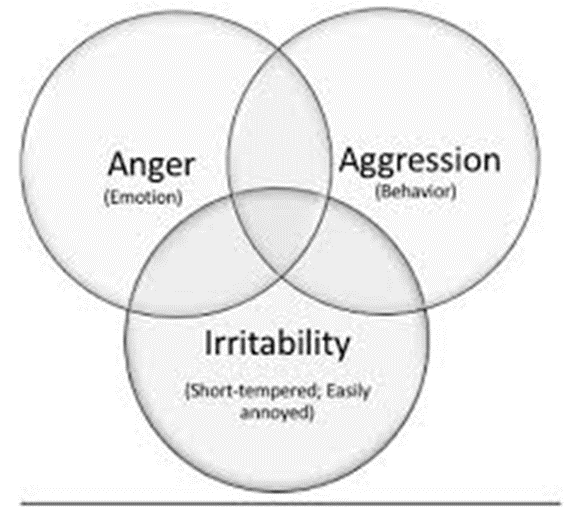An inpatient client who has a known history of violence suddenly begins to pace. Which additional client behavior should alert the nurse to escalating anger and aggression? The client:
Sits in group with back to peers.
Has a tense facial expression and body language.
Requests PRN medications.
Does not want to eat lunch.
The Correct Answer is B
Choice A Reason: Sits in group with back to peers
Sitting with one’s back to peers can indicate a desire for isolation or a lack of trust, but it is not a definitive sign of escalating anger or aggression. This behavior might be more indicative of withdrawal or discomfort in social settings rather than an immediate precursor to violence.
Choice B Reason: Has a tense facial expression and body language
This is the correct answer. Tense facial expressions and body language are clear indicators of escalating anger and aggression. Signs such as clenched fists, a rigid posture, and a furrowed brow are physical manifestations of internal tension and can precede aggressive outbursts. Recognizing these non-verbal cues is crucial for early intervention and de-escalation.

Choice C Reason: Requests PRN medications
Requesting PRN (as needed) medications can be a sign that the client is experiencing increased anxiety or distress. However, this behavior alone does not necessarily indicate escalating aggression. It may actually be a positive sign that the client is seeking help to manage their symptoms before they escalate.
Choice D Reason: Does not want to eat lunch
A lack of appetite or refusal to eat can be associated with various conditions, including depression, anxiety, or physical illness. While it may indicate that the client is not feeling well, it is not a specific indicator of escalating anger or aggression.
Nursing Test Bank
Naxlex Comprehensive Predictor Exams
Related Questions
Correct Answer is B
Explanation
Choice A Reason:
Somatic.
Somatic delusions involve a false belief that there is something physically wrong with one’s body, such as having a serious illness or a physical defect. In this scenario, the client’s belief that the food is poisoned does not relate to their own body but rather to an external threat, making somatic delusions an incorrect classification.
Choice B Reason:
Persecutory.
This is the correct response. Persecutory delusions, also known as paranoid delusions, involve the belief that one is being targeted, harassed, or conspired against. The client’s statement that the staff is poisoning the food reflects a belief that they are being harmed or targeted, which is characteristic of persecutory delusions. These types of delusions are the most common in schizophrenia and often involve themes of being persecuted or plotted against.
Choice C Reason:
Erotomanic.
Erotomanic delusions involve the false belief that another person, often someone of higher status, is in love with the individual. This type of delusion is not relevant to the client’s statement about the food being poisoned, as it does not involve any romantic or affectionate themes.
Choice D Reason:
Grandiose.
Grandiose delusions involve an inflated sense of one’s own importance, power, knowledge, or identity. The client’s belief about the food being poisoned does not reflect an exaggerated sense of self-importance or power, making grandiose delusions an incorrect classification for this scenario.
Correct Answer is D
Explanation
Choice A Reason:
Hypertension.
Hypertension, or high blood pressure, is not a common side effect of lorazepam. Lorazepam is a benzodiazepine, which typically causes sedation and relaxation of muscles, leading to a decrease in blood pressure rather than an increase. Therefore, hypertension is not an expected side effect of this medication.
Choice B Reason:
Tinnitus.
Tinnitus, or ringing in the ears, is also not commonly associated with lorazepam use. While tinnitus can be a side effect of various medications, it is not typically linked to benzodiazepines like lorazepam. Therefore, it is not an expected side effect for clients taking this medication.
Choice C Reason:
Metallic taste.
A metallic taste is not a common side effect of lorazepam. This side effect is more often associated with other medications, such as certain antibiotics or chemotherapy drugs. Lorazepam’s side effects are more related to its sedative properties.
Choice D Reason:
Dizziness.
Dizziness is a common side effect of lorazepam. As a central nervous system depressant, lorazepam can cause drowsiness, dizziness, and lightheadedness. Clients should be advised to avoid activities that require alertness, such as driving, until they know how the medication affects them.
Whether you are a student looking to ace your exams or a practicing nurse seeking to enhance your expertise , our nursing education contents will empower you with the confidence and competence to make a difference in the lives of patients and become a respected leader in the healthcare field.
Visit Naxlex, invest in your future and unlock endless possibilities with our unparalleled nursing education contents today
Report Wrong Answer on the Current Question
Do you disagree with the answer? If yes, what is your expected answer? Explain.
Kindly be descriptive with the issue you are facing.
